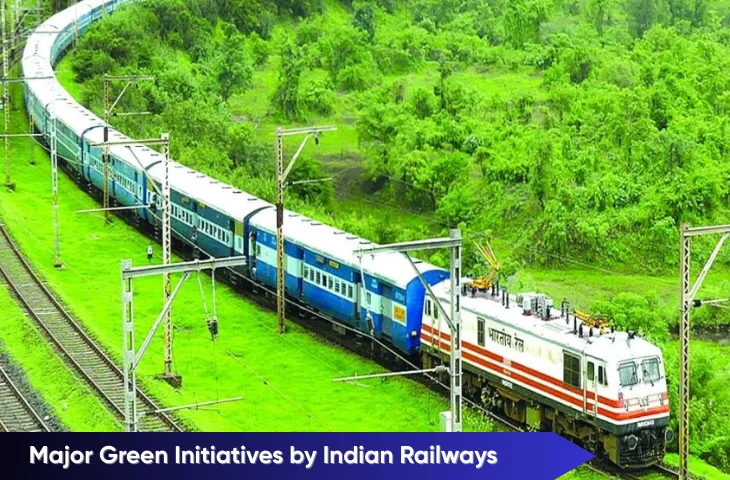Green Initiatives by Indian Railways: The Indian Railways is not only the backbone of the country’s transportation system but also one of the largest organizations in the world. With more than 68,000 kilometers of rail tracks and serving over 2 crore passengers daily, it plays a vital role in the economy and connectivity of India.
However, such a vast network also comes with challenges, especially environmental issues. From air and noise pollution to excessive use of resources, railways contribute to environmental degradation. Recognizing this, Indian Railways has undertaken multiple green initiatives to reduce its ecological footprint and move towards sustainability.
In this article, we will explore the major environmental issues linked with Indian Railways and the steps taken to make it eco-friendly.
Environmental Issues Related to Indian Railways
1. Air Pollution
Traditionally, Indian Railways relied heavily on diesel locomotives, which release carbon dioxide, nitrogen oxides, and particulate matter into the atmosphere. These emissions not only contribute to air pollution but also add to climate change.
2. Noise Pollution
Train horns, engine noise, and vibrations from running on tracks contribute significantly to noise pollution, especially in urban areas and near railway stations. Continuous exposure to such noise can disturb wildlife habitats and also affect human health.
3. Energy Consumption
Indian Railways is one of the largest consumers of electricity and fuel in the country. Running thousands of trains daily requires massive energy, most of which comes from non-renewable sources like coal and diesel.
4. Waste Generation
With millions of passengers traveling daily, railway stations and trains generate huge amounts of plastic waste, food waste, and non-biodegradable material. Open disposal of such waste pollutes the environment and clogs drainage systems.
5. Deforestation & Land Use
Expansion of railway tracks often requires cutting down trees, clearing land, and disturbing ecosystems, which impacts biodiversity and natural habitats.
6. Water Pollution
Cleaning of trains, discharge of waste, and improper drainage around railway tracks and stations often lead to contamination of nearby water bodies.
Green Initiatives by Indian Railways
To address these issues, Indian Railways has launched several sustainable and eco-friendly measures. These initiatives aim not only to minimize environmental damage but also to make the railways a role model for green transportation.
1. 100% Electrification Target
Indian Railways has set an ambitious goal to achieve 100% electrification of its broad-gauge network by 2030. This move will reduce dependence on diesel and cut down carbon emissions drastically.
2. Renewable Energy Adoption
- Solar Power: Solar panels have been installed on train coaches, station rooftops, and office buildings.
- Wind Power: Railways are also exploring wind energy projects to power operations.
- Green Energy Mix: The goal is to source at least 20% of total energy needs from renewable sources.
3. Bio-Toilets in Trains
Railways have introduced bio-toilets in coaches to prevent open discharge of human waste on tracks. These eco-friendly toilets use bacteria to decompose waste, improving hygiene and reducing pollution.
4. Energy-Efficient Technology
- Use of LED lights in stations and trains.
- Energy-efficient fans and equipment in coaches.
- Introduction of modern electric locomotives that consume less energy.
5. Green Certifications for Stations
Several major stations like New Delhi, Secunderabad, and Jaipur have received ISO 14001 Environmental Management Certification for adopting eco-friendly practices.
6. Plastic Ban Initiatives
Railways have implemented a ban on single-use plastic across stations and trains. Instead, alternatives like paper cups, biodegradable plates, and reusable bottles are encouraged.
7. Water Conservation Measures
- Installation of rainwater harvesting systems at stations.
- Recycling plants to treat wastewater for reuse in cleaning and gardening.
- Use of aerated taps to reduce water wastage.
8. Green Stations Development
Under the “Green Railway Stations” initiative, Indian Railways is upgrading selected stations with:
- Solar power plants.
- Waste segregation systems.
- Energy-efficient buildings.
- Tree plantation drives.
9. Afforestation and Tree Plantation
To compensate for deforestation, Indian Railways regularly conducts tree plantation drives along railway tracks and station premises. This helps reduce carbon footprint and improves the environment.
10. Noise Pollution Control
Railways are working on:
- Using electric engines, which are quieter than diesel locomotives.
- Installing sound barriers near residential areas and sensitive zones.
Indian Railways’ Goal of Net-Zero Carbon Emission
One of the most remarkable steps is the commitment to become a net-zero carbon emitter by 2030. This includes:
- Electrification of all trains.
- Increasing reliance on renewable energy.
- Promoting energy-efficient technologies.
- Green building certifications for stations.
If achieved, Indian Railways will become the world’s first large-scale railway network to operate with net-zero carbon emissions.
Challenges in Implementing Green Initiatives by Indian Railways
While the efforts are commendable, challenges remain intact. Some of the major challenges faced by Indian Railways include:
- High cost of renewable projects like solar and wind plants.
- Maintenance of bio-toilets in trains.
- Behavioral change among passengers to avoid littering.
- Balancing expansion projects with environmental conservation.
Role of Passengers in Green Initiatives by Indian Railways
A green railway system cannot be achieved by government efforts alone. Passengers must also contribute by:
- Avoiding plastic use during travel.
- Disposing of waste properly in dustbins.
- Conserving water in train washrooms.
- Supporting eco-friendly products on trains and at stations.
By aiming for net-zero carbon emissions by 2030, Indian Railways is not just serving passengers but also contributing towards India’s fight against climate change. With continued innovation, investment, and passenger support, Indian Railways can truly become the green lifeline of the nation.
FAQs
Indian Railways has set an ambitious goal to achieve 100% electrification of its broad-gauge network by 2030. Railways have also introduced bio-toilets in coaches to prevent open discharge of human waste on tracks
Some of the challenges faced by Indian Railways include the high cost of renewable projects like solar and wind plants, maintenance of bio-toilets in trains, behavioral change among passengers to avoid littering, and more
Indian Railways has set an ambitious goal to achieve 100% electrification of its broad-gauge network by 2030.
To compensate for deforestation, Indian Railways regularly conducts tree plantation drives along railway tracks and station premises. This helps reduce carbon footprint and improves the environment.
Several major stations like New Delhi, Secunderabad, and Jaipur have received ISO 14001 Environmental Management Certification for adopting eco-friendly practices

Hello! This is Arijit Dutta. I am a skilled Content Writer at Oliveboard with nearly 3+ years of experience in crafting engaging, informative, and exam-focused content for the Railways Domain. With a strong command of language and a keen understanding of learner needs, I contribute significantly to Oliveboard’s mission of delivering high-quality educational resources. Passionate about clear communication and continuous learning, I consistently create content that helps government job aspirants achieve their goals. Outside of work, I enjoy playing cricket and listening to music, which helps me stay balanced and creative in my professional journey.
